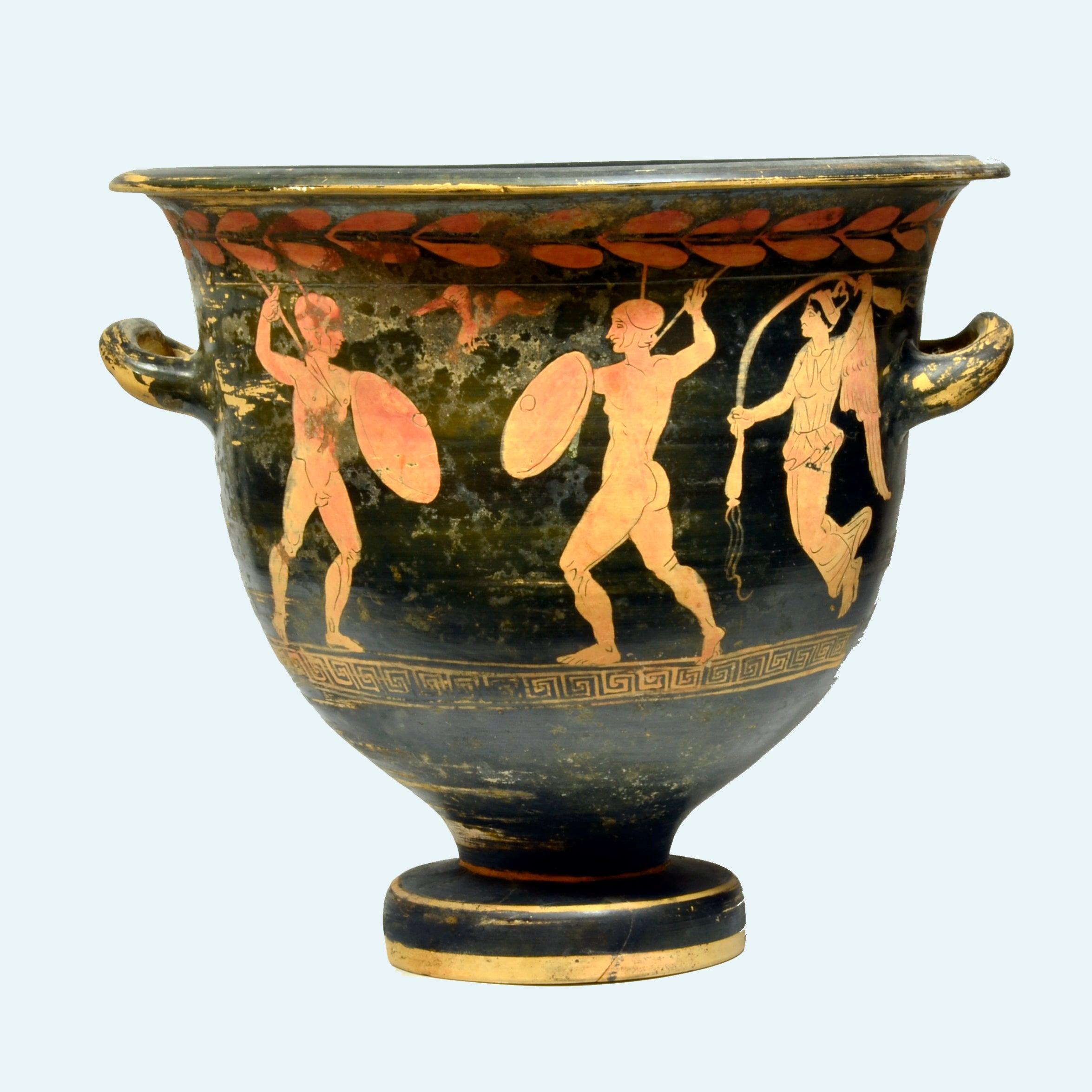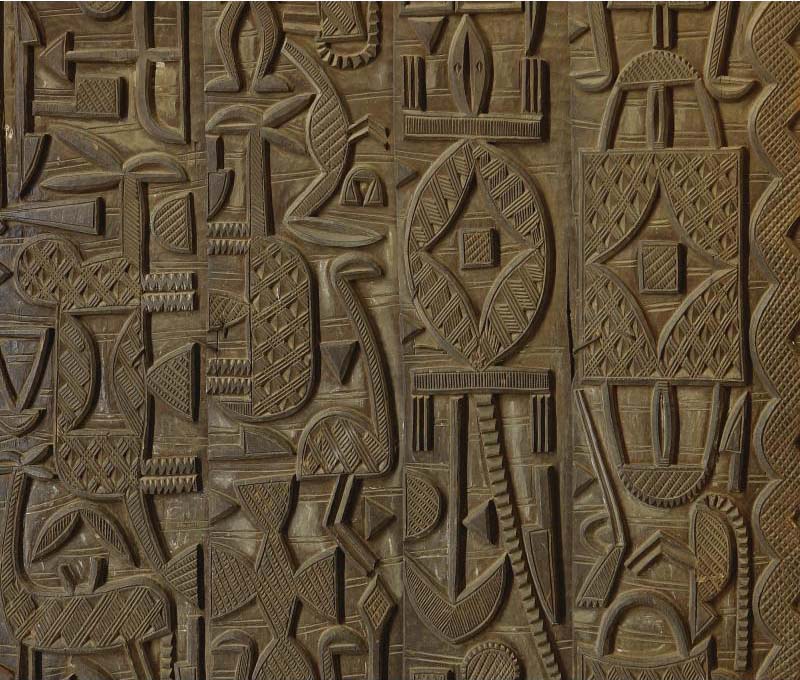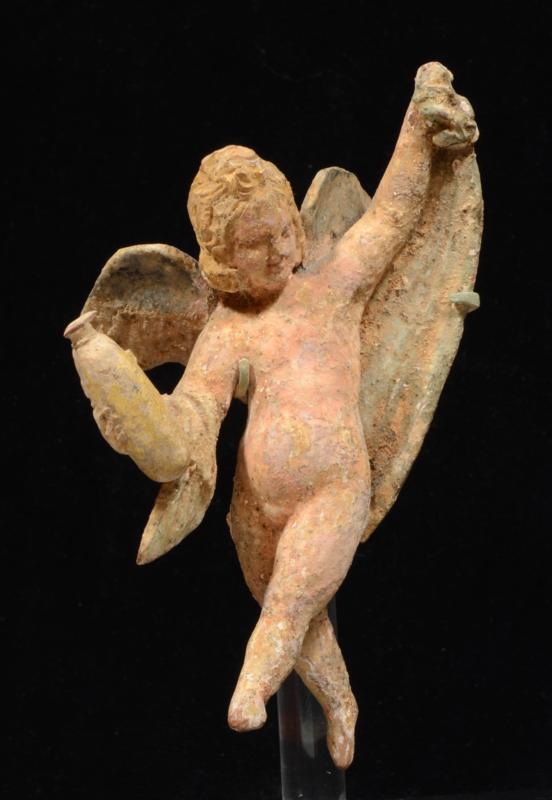The Callery Idol

GREEK CYCLADIC, EARLY BRONZE AGE II, CIRCA 2600-2400 BC
7.25 inches (18.4cm)
“So, my idol has no belly. It’s a goddess, if you like—anyway a magic object; it’s no longer a fertility figure. All that’s left are small, flat breasts and engraved lines for the arms. Better than Brancusi. Nobody has ever made an object stripped that bare.” --Picasso, to Malraux 1944 (Picasso’s Mask, by Andre Malraux, Holt Rinehart and Winston, 1974)
The Callery idol has legs slightly bent at the knees, two small protruding breasts, forearms folded over the abdomen, an elongated neck (repaired), sloping shoulders and a flaring head with a long aquiline nose. The details of the body are finely incised, the surface heavily encrusted, with a scratch to the left side of the face. With its long neck, narrow torso and linear, geometric form, the Callery idol exemplifies the Late Spedos type.
The Cyclades (‘kyklos’ in Greek), small, rocky islands that encircle the sacred island of Delos, are the mythical birthplace of Apollo and Artemis, the twin offspring of Zeus. Sandwiched between the Mycenean culture of mainland Greece and the Minoans of Crete, Cycladic civilization was one of three cultures that dominated the Aegean during the 3rd millennium BC. While the islands weren’t conducive to agriculture, because of their position on ancient trade routes they were unlikely power players in the Bronze Age Mediterranean, and developed a distinctive, and extremely influential, style of art.
With the emergence of the Keros-Syros Culture (of the Early Cycladic II period, ca 2700-2300 BC), folded arm style marble figurines –now emblematic of Neolithic art—became omnipresent, not just amongst the Cyclades, but throughout the Aegean. They represent the earliest and only known depictions in Greek art of nude females until the 4th century BC and are among the most compelling and iconic images from antiquity. There is no consensus amongst scholars as to what their use and meaning was in Cycladic culture. Since they were buried with the deceased as grave goods some scholars hold that they were used to venerate ancestors and to connect with the souls of the dead. Others theorize that they were believed to possess apotropaic qualities, providing spiritual protection in journeys to the afterlife. It’s possible they were considered conduits, allowing for communication with the spiritual realm.
While idols have been found in settlements, most were deposited in graves, thus the two Cycladic periods are named after significant burial sites. Having been produced for over a millennium, the style of the idols evolved and there are five canonical types. The Callery idol is of the Late Spedos type, named after a cemetery on Naxos. Female in form, with a slender figure, breasts far apart in high relief, and an incised triangle above the legs, she has the distinctive flat proportions that typify Spedos idols. Her convex face, rounded chin, and long narrow nose are typical of the Spedos’ U-shaped head, and her broad sloping shoulders and carved crossed arms are on par with the Late Spedos style.

Although the bottoms of her legs are missing, they are carved slightly spread apart, and the knee of her right leg is slightly raised, also typical of Late Spedos. She has a particularly long neck and remains in uncleaned, original condition. This figurine’s form is beautifully carved and is a wonderful representation of the Cycladic style, which had wide and deep influence on its contemporary cultures, particularly the Minoans and Myceneans, with these idols being found as far as Portugal and the Danube.
Whatever their original meaning, Cycladic idols have been objects of fascination since they were re-discovered in the nineteenth century, and they profoundly inspired avant-garde modern masters such as Brancusi, Moore, Arp, Modigliani and Picasso.
Picasso spoke at length of his own fascination with the sculptures in his conception of “the Little Man from Cyclades,” which he voiced to Andre Malraux in 1944, in Paris.
“From time to time I think: there once was a Little Man from the Cyclades. He wanted to make this really terrific piece of sculpture, just like that, right? Exactly like that. He thought he was making the Great Goddess, or something to that effect. But what he made was that. And I, here in Paris, I know what he wanted to make: not a god, but a piece of sculpture. Nothing's left of his life; nothing's left of his kind of gods; nothing's left of anything. Nothing. But this is left, because he wanted to make a piece of sculpture.” -- (Picasso’s Mask, by Andre Malraux, Holt Rinehart and Winston, 1974)
These words are particularly pertinent to the Callery idol because, according to (very believable) family lore, it was a gift to Mary Callery from Picasso. The Picasso-Callery relationship is well known and well documented.

Provenance
The Callery idol comes, through descent, from the estate of Mary Callery. Callery was an American artist associated with modernism and post–World War II Abstract Expressionism. She came from a wealthy Pittsburgh family and decamped to Paris in 1930 with the goal of studying art. In Paris she became deeply involved with the evolving modernist art scene and was one of the only female artists to gain recognition in that circle. Callery's early work was influenced by classical and Renaissance sculpture, but gradually shifted towards modern and abstract styles. Her sculptures often featured geometric forms and expressive, organic shapes.
Throughout her career, Callery exhibited her work extensively in the United States and Europe, and was shown regularly at prominent galleries in New York, Chicago, Boston, and Paris. She received numerous awards and honors, including the Logan Medal of the Arts from the Art Institute of Chicago in 1965.


Callery’s work can be found in the Met, MoMA and the Whitney, among others. Perhaps her most well known piece lives on the proscenium in the Metropolitan Opera House in NYC.

Callery’s bust of close friend, Georgia O’Keefe, is held at the Met. Perhaps the most iconic portrait of O’Keefe, taken by Eliot Porter in 1945, features O’Keefe gazing at herself: the plaster cast of Callery’s sculpture.

While Callery, who also went by the androgynous name, Meric Callery, was a distinguished and recognized artist in her own time, her work has been overshadowed by her uncanny ability to recognize, befriend—and voraciously collect—artists who would become world renowned. She often served as muse to the (almost entirely male) artists who would be lionized as the forbears of modern art and architecture globally.
She is perhaps most well known for being an early and avid collector of Picasso, at one time holding the largest collection of his work in the US. Many pieces from her collection, including Nude Woman (1910), The Bather (1929), and Le Reve, (1932) are now held in MoMA, the Met, the Whitney and other major institutions.
When Alfred Barr, first director of MoMA, was organizing the first Picasso show at the museum he wrote to Callery: “We would very much appreciate having your sympathetic interest in the rather complex problem of maneuvering through the devious intrigues which surround Picasso. Picasso’s own good will I believe we have, but he is capricious and irresponsible…I would greatly appreciate your keeping us informed, if you can, of his state of mind…”

Callery wrote an essay about Picasso, published in ArtNEWS in 1942. Due to the war she had returned to the States, while Picasso remained in Paris. “For years Picasso teased me about my work since I did not have the courage to show it to him. I am a sculptress, and each evening as we, his little group, gathered together he would look at me, his intelligent keen eyes twinkling and say, “Well, what have you done today, a seascape?” She ends on a dark note; “And there, in that stricken Paris, he still is. … Our thoughts go out to him and worry over him.”

Twenty-one letters from Callery to Picasso reside in the archives of the Musee Picasso in Paris. The archives are currently under renovation and inaccessible.
Upon her death in 1977 the idol was passed to her niece, the Baroness Marcella Heron Korff, and then, in 2008, to Korff’s daughter, who has issued an affidavit stating that the idol was a gift from Picasso to Callery. 











